Home > News > Derby News > Tales from the Crib: Dornoch
Tales from the Crib: Dornoch
Mar 08, 2024 Kellie Reilly/Brisnet.com
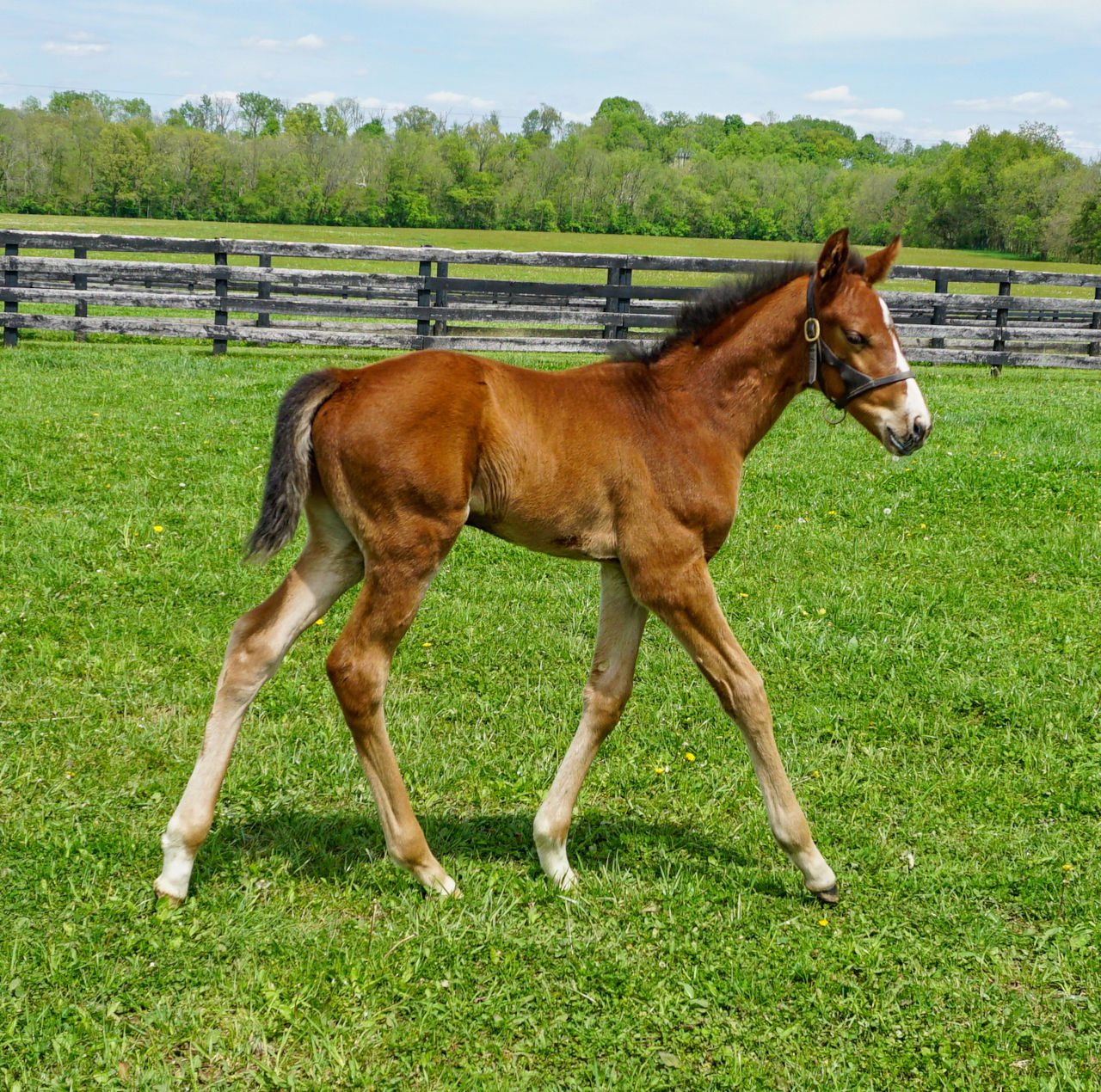
Dornoch liked to express himself as a foal (Photo by Runnymede Farm)
The 150th running of the Kentucky Derby (G1) will spark celebrations of the race’s rich history, but Dornoch could top them all with an unprecedented feat. One year after his brother Mage starred in the “Run for the Roses,” Dornoch aims to complete the first-ever sibling double in the Derby.
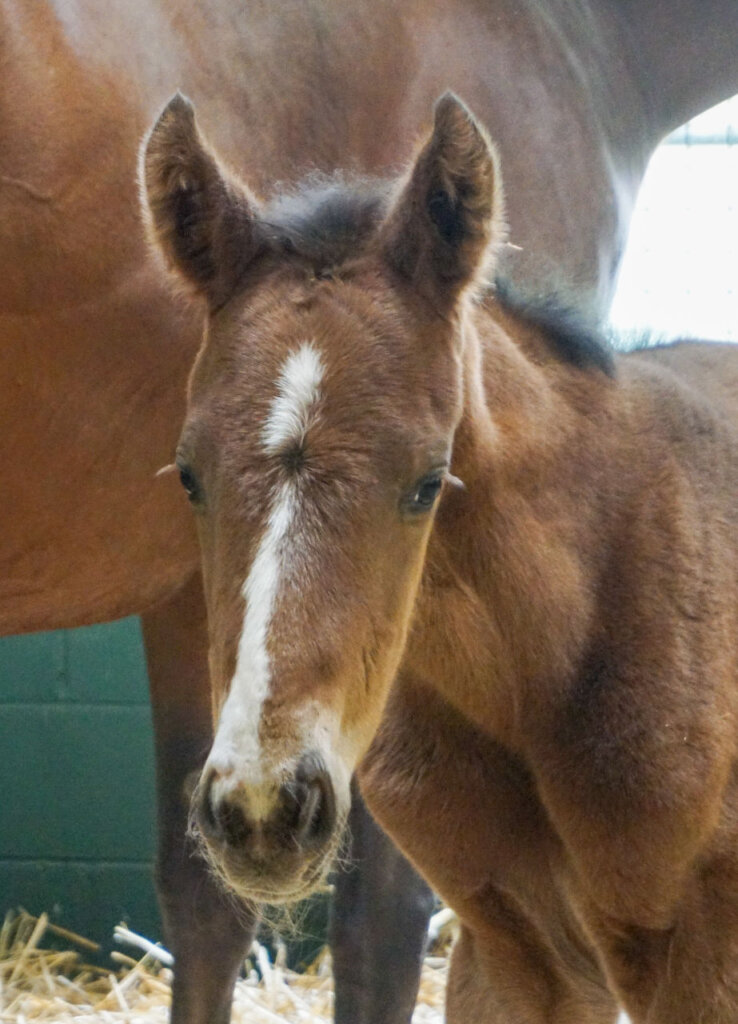
Dornoch as a newborn (Photo by Runnymede Farm)
But the historic appeal goes even further. Dornoch and Mage were both raised at a nursery steeped in Bluegrass lore – Runnymede, hailed by the Daughters of the American Revolution as the oldest continuously operated Thoroughbred farm in Kentucky. Runnymede’s history itself reflects brothers forging their own paths in life, lending another dimension to the tale of siblings on the Derby trail.
Mage and Dornoch were bred by a partnership of more recent vintage, Grandview Equine, masterminded by Robert N. Clay. Best known for establishing Three Chimneys, which stood such luminaries as Triple Crown legend Seattle Slew, Clay sold the stud farm in late 2013. He subsequently formed Grandview as a fresh way to be involved, and invested, in the Thoroughbred industry.
Grandview acquired a few select mares, including Puca, a graded stakes-caliber daughter of 2008 Kentucky Derby champion Big Brown. Puca was purchased for $475,000, carrying her first foal, at Fasig-Tipton Kentucky November in 2018.
PUCA is one proud Momma of a #KyDerby winner! 🌹
She received a very special #MothersDay gift from @ftdflowers! 💐 pic.twitter.com/AAeoTabzVa
— Kentucky Derby (@KentuckyDerby) May 14, 2023
Puca took up residence at Runnymede, operated by four successive generations of another Clay family. Boasting a remarkable degree of historic continuity since 1867, the Bourbon County establishment thus marked its own sesquicentennial seven years ago.
Runnymede’s historical connotations, however, go back more than 800 years. The farm’s name refers to the meadow where the English barons prevailed upon King John to sign the Magna Carta in 1215. With its legacy of safeguarding rights against the overweening claims of the crown, the “Great Charter” ranks as a seminal document in legal history, and a formative influence on the founding fathers of the United States.
The great 19th-century statesman from Kentucky, Henry Clay, was a significant Thoroughbred breeder himself. He’s also a distant relation of the Clays of our story, Robert Clay of Grandview, as well as the Clays of Runnymede.
Nothing is better for the soul than mist-kissed mornings at Runnymede farm.#HorseRacing #Thoroughbred #ThoroughbredCountry #HorseCapital #HallwayFeeds #FedByHallway #KentuckyHorses pic.twitter.com/vfbNl7GrJ2
— Hallway Feeds (@HallwayFeeds) September 17, 2023
Runnymede founder Col. Ezekiel Clay had a colorful history. “Zeke” was the son of Congressman Brutus Clay and nephew of the abolitionist Cassius Clay. (That might sound familiar, as the original name of legendary boxer Muhammad Ali.) Despite furious opposition from his family, Zeke fought on the side of the Confederacy in the Civil War, lost an eye in battle, and ended up as a prisoner of war. His father, who sought his release from President Abraham Lincoln, graciously helped Zeke get set up on the property that became Runnymede.
The farm soon became a prolific source of outstanding performers, often bred by Col. Clay in partnership with his brother-in-law, Catesby Woodford.
BEN BRUSH was the 22nd running of the @KentuckyDerby.
Ben Brush was one of the original inductees into the Racing Hall of Fame at its founding in 1955.
The first modern Olympic games are held in Athens in 1896.
129 days till #KyDerby150 pic.twitter.com/DVwT66BPxr
— TwinSpires Racing 🏇 (@TwinSpires) December 27, 2023
Hall of Famers Hanover, Miss Woodford, Ben Brush, and Roamer all arose from the iconic hills and mineral-laden pastures of Runnymede. Hanover begins the farm’s classic honor roll, courtesy of the 1887 Belmont. Sir Dixon made it two in a row in the 1888 Belmont, and Buddhist added the Preakness to the ledger in 1889.
Ben Brush became the first Kentucky Derby winner from Runnymede in 1896, followed by Agile in 1905. Decades later, along came another Derby winner in Count Turf (1951), whose breeder, Dr. Frank Miller, was leasing Runnymede at the time. That brief interregnum, so to speak, occurred when Col. Clay’s grandson Brutus Clay left the Thoroughbred world to join the Jesuits.
Then Catesby Clay, Brutus’ brother, took on the task of leading Runnymede with great success for more than half a century. During his tenure, the farm became prominent on the world stage, in addition to continuing to produce top-caliber runners closer to home, including 1995 Derby runner-up Tejano Run. Just within the past decade, Eclipse Award champion Lady Eli – Runnymede-bred on both top and bottom – and Collected have upheld the lofty strike rate for a farm emphasizing quality over quantity.
Happy 100th birthday to @runnymedefarmky's Catesby Clay. Chris McGrath's story @theTDN https://t.co/YiALPlBt5M
— Sue Morris Finley (@suefinley) July 25, 2023
Catesby’s son Chris appeared to be the logical successor, until he discerned a vocation to the priesthood in the diocese of Lexington. Thus in 2009, the role of shepherding Runnymede went to another accomplished son of Catesby, Chris’s brother Brutus Clay III.
Mage and Dornoch have the same vocation as racehorses, but the brothers are different individuals, with contrasting arcs of development on the Derby trail.
Puca visited champion Good Magic when he retired to stud because Grandview owned shares in the young stallion. She delivered a chestnut colt on April 18, 2020, the future Derby winner Mage. Bred right back to Good Magic, Puca produced another colt, but a bay, of a different physical stamp. That foal of April 22, 2021 would ultimately be called Dornoch.
Mage won the 149th Kentucky Derby on Saturday. He was born and raised at Runnymede Farm in Bourbon County, Kentucky.
Those who cared for him early on say there's something about him that made him a bit different from other three-year-olds. pic.twitter.com/JuQTlrZzyO
— Austin Pollack (@AustinPollackTV) May 9, 2023
Romain Malhouitre, who serves as Runnymede’s president and general manager, commented on the differences between Mage and Dornoch, as well as a key similarity.
“Physically, they are very different,” Malhouitre observed. “One was more compact, like Good Magic, Mage, while Dornoch was a big, tall, two-turn horse.
“Dornoch had more scope and length, looking very much like his mother, while Mage was very much like his father.”
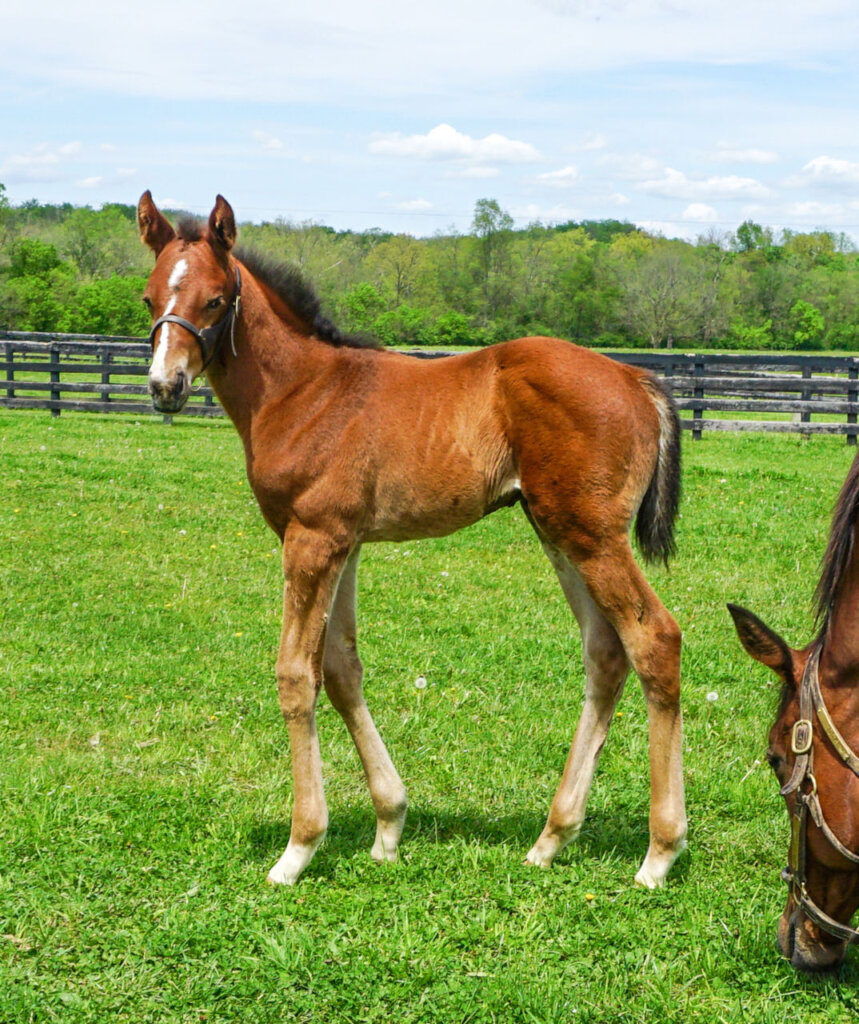
Dornoch poses as mom Puca grazes (Photo by Runnymede Farm)
Along with Dornoch’s bigger size came a more expressive personality.
“Mage was always confident, but he just didn’t express as much ego when he was younger,” Malhouitre noted. “He was a good boy from day one, did what you asked him to do.
“Dornoch had way more ego” as a baby – never in a bullying manner, but just out of exuberance.
“He was ready to jump, ready to go forward,” with an “‘everyone’s looking at me’ attitude when he was a young foal.”
For that reason, baby Dornoch required a skilled handler. If he detected any weakness, he would take advantage, as often happens with larger foals who are aware of their strength.
“He wanted to express himself,” Malhouitre explained. “He was never dangerous; he just had a lot of confidence about himself when he was younger.”
Dornoch became “less of a character as a yearling,” and Malhouitre credits the farm’s yearling team that helped teach him how to channel his personality.
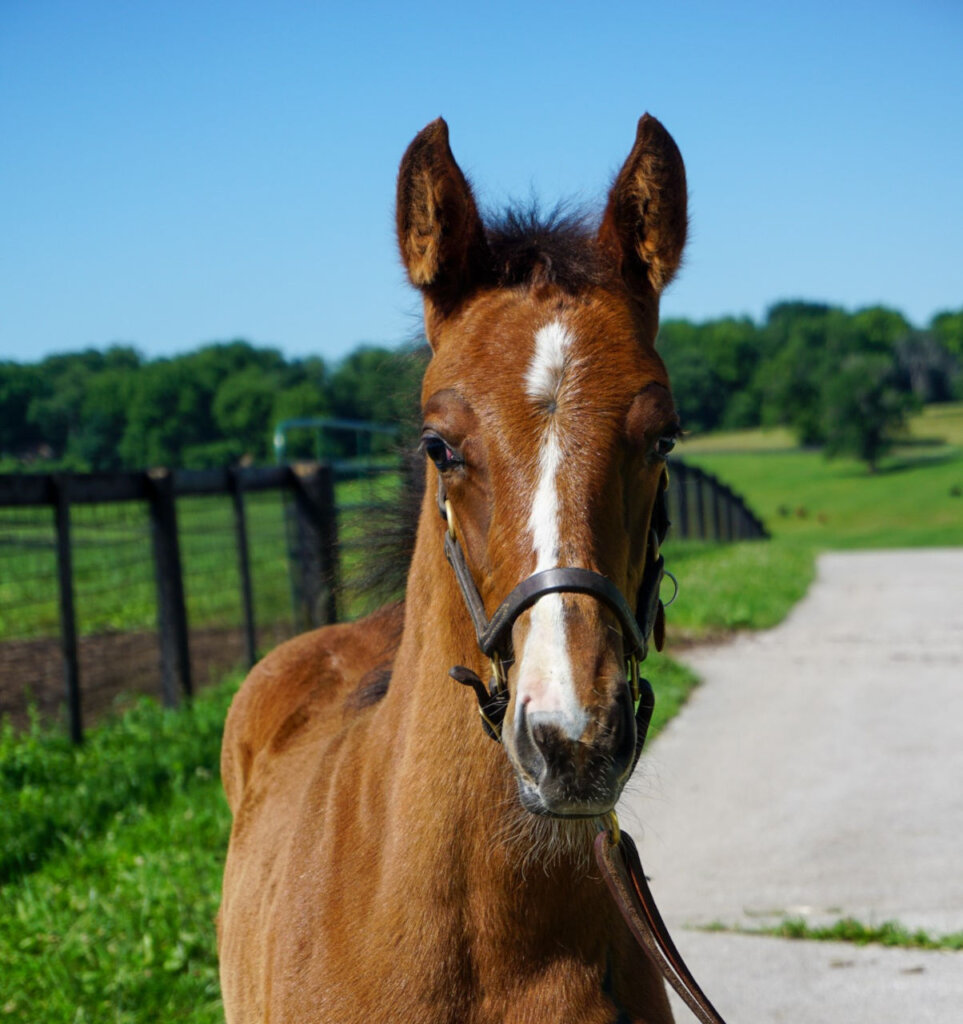
Dornoch was a quiet leader (Photo by Runnymede Farm)
But Dornoch was like Mage in an important respect: both had a “quiet presence” in the field that the other yearlings sensed, Malhouitre recalled. Often youngsters can come back with bruises, bumps, and cuts from roughhousing, but not Mage or Dornoch. No one tried to pick on them, or start anything, because they knew better.
“The quieter ones have earned respect,” Malhouitre said. “They were showing leadership, in a quiet way. The common theme of the two of them – they were kind of quiet leaders as yearlings.”
Both were also bound for the Keeneland September Yearling Sale in their respective years. While Mage sold for $235,000 in 2021, Dornoch commanded $325,000 the following September from Conor Foley’s Oracle Bloodstock, as agent.
Foley was already a part of Dornoch’s family story, going back to Puca’s early days. She had been bred by Donegal Racing’s Jerry Crawford on a foal share with the late Paul Pompa Jr. Foley, in his role assisting Donegal, was keeping an eye on how Puca was developing as a yearling ahead of her date at Keeneland September in 2013.
“I’d gone to see her a couple of times at the farm, and she really blossomed the last couple of months before the sale. I was insistent that Jerry buy out Pompa,” Foley said.
Crawford did indeed purchase Puca for $90,000, and she proved worthy of the investment for Donegal Racing. Trained by Hall of Famer Bill Mott, Puca broke her maiden by 16 lengths at Belmont Park, and Thoroughbred Daily News officially branded her a “Rising Star.”
Unfortunately, Puca’s racing career didn’t quite live up to the tantalizing promise of her maiden romp. She was an unlucky sixth in the 2014 Breeders’ Cup Juvenile Fillies (G1), where she arguably would have been involved in the finish if not for traffic trouble. Runner-up in the 2015 Gazelle (G2) and 12th in the Kentucky Oaks (G1), she eventually won a minor stakes on the turf at Suffolk Downs in 2017, beating Queen Caroline (later the dam of champion Forte).
September 2, 2017 -- Donegal Racing’s Puca rolled to an authoritative victory in the $75,000 Steve Pini Memorial Stakes. @DonegalRacing
Trained by Hall of Fame conditioner Bill Mott, she was ridden by Abel Lezcano. pic.twitter.com/5hE9MAbNLH— Suffolk Downs (@SuffolkDowns) September 10, 2020
Although Puca compiled a respectable bankroll of $299,406, with a record of four wins and three placings from 17 starts, her results may not have truly reflected her raw talent.
“Felt that something was left on the table, with how good she was,” Foley said.
“I had a big affinity for her.”
Given Puca’s backstory, Foley wanted to buy Mage when he turned up as a two-year-old in training at Fasig-Tipton’s Midlantic May Sale in 2022. But he was outbid, and for $290,000, Mage went to other connections who nurtured him into a Derby winner.
Just a few months later, though, Foley got a chance to snare another son of Puca when her bay yearling entered the ring at Keeneland September.
Aside from his Puca connection, there was plenty of appeal in sourcing prospects from Runnymede, “one of the best nurseries to raise Thoroughbred athletes.”
This one was a “bigger physical athlete than his older brother (Mage),” noted Foley, who saw much more of Good Magic in Mage.
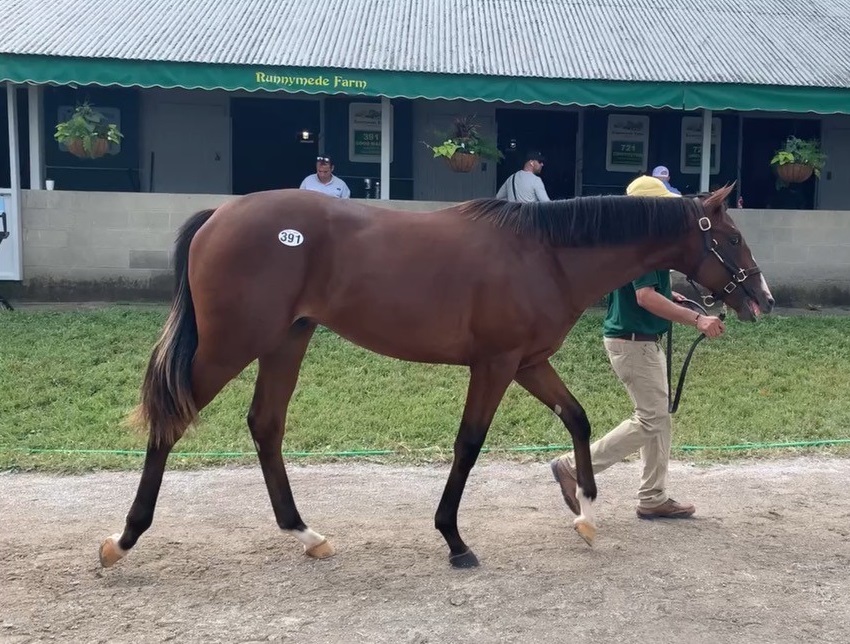
Dornoch as a yearling on the Keeneland sales grounds (Photo courtesy of Conor Foley)
Nine years after his role in acquiring Puca herself, Foley was about to come full circle. But it very nearly didn’t happen.
“I almost forgot to bid on the horse! He sold very early on the day he sold, and I was looking at other horses who would sell the next day.
“Oh my gosh! I had to run up to the ring and got there just in time,” Foley revealed. “I remember the experience well just because I freaked out about it.”
It was a case of all’s well that ends well, as his Oracle Bloodstock secured the yet-unnamed colt for $325,000 in collaboration with trainer Danny Gargan.
“I thought he would cost more than he did,” Foley said, “for how nice he was, selling at that stage of the sale.”
DORNOCH (Good Magic) battles back to win the GII Remsen over SIERRA LEONE (Gun Runner). Here's Mage's lil' bro last year at @runnymedefarmky prior to selling for $325k as a KEESEP yearling
-- @GarganRacing @luissaezpty @caseclay1 @HillnDaleFarm @RMalhouitre pic.twitter.com/47xyC0i4eB
— Lucas Marquardt (@ThoroStride) December 2, 2023
For his early education, Dornoch was sent to Raul Reyes at his famed Kings Equine in Ocala, Florida. At the cleverly-named academy that he operates with his wife, Martha, Reyes has tutored such stars as Hall of Famer Beholder.
Foley praised Reyes for how he prepared Dornoch for the racetrack: “Raul did super job with him.”
Part of that job was solving a problem that cropped up at one stage.
“When he started training, he did show a lot of talent,” Reyes said, but “then he went a little funny.”
Dornoch was not moving as well in behind, and Reyes was the one who figured out the cause of the juvenile’s discomfort – a testicular issue. That can happen with developing youngsters, as one testicle may not descend. The simple solution is to remove it, with no barrier to a future career at stud. The poster boy for that is Hall of Famer and supersire A.P. Indy.
The procedure made an instant difference for Dornoch, who resumed his training with gusto, and for good.
“He made a 360-degree turnaround,” Reyes said. “He showed a lot of talent when I had him.
“He looked like a good horse, and reminded me of the good horses I’ve had. They like to train and have a big stride.
“He was a very nice horse to be around, a gentleman,” Reyes summed up.
Graduating to join Gargan’s barn at Saratoga, the two-year-old posted his first official breeze on May 16, 2023, just 10 days after Mage’s heroics at Churchill Downs.
As if his status as the reigning Derby winner’s brother, and their upbringing at Runnymede, weren’t enough for history buffs, Dornoch’s name adds more mystique. It refers to the Royal Dornoch Golf Club in the Scottish Highlands, where the game has been played for at least four centuries. The earliest written attestation dates to 1616, suggesting that the history of golfing at Dornoch is even older.
We are delighted to be shortlisted for the accolade as “Scotland’s Best Golf Course 2024” in the World Golf Awards.
Find out more and cast your vote 👇https://t.co/5qsJznmd0t
— Royal Dornoch (@RoyalDornochGC) February 28, 2024
Dornoch has made a splash on the racetrack a lot sooner than Mage, who didn’t start his career until he turned three. Dornoch’s juvenile campaign, capped by his Remsen (G2) victory, contributed to a terrific year for the whole family. Their younger half-brother (by McKinzie) commanded $1.2 million as a Keeneland September yearling, and Puca herself topped the auction house’s November Sale at $2.9 million.
With his victorious comeback in the Fountain of Youth (G2), Dornoch extended his winning streak to three. If Dornoch can keep the momentum going through the 2024 Kentucky Derby, maybe one day Mage will be remembered as Dornoch’s brother.
Ticket Info
Sign up for race updates and more
THANK YOU TO OUR SPONSOR
